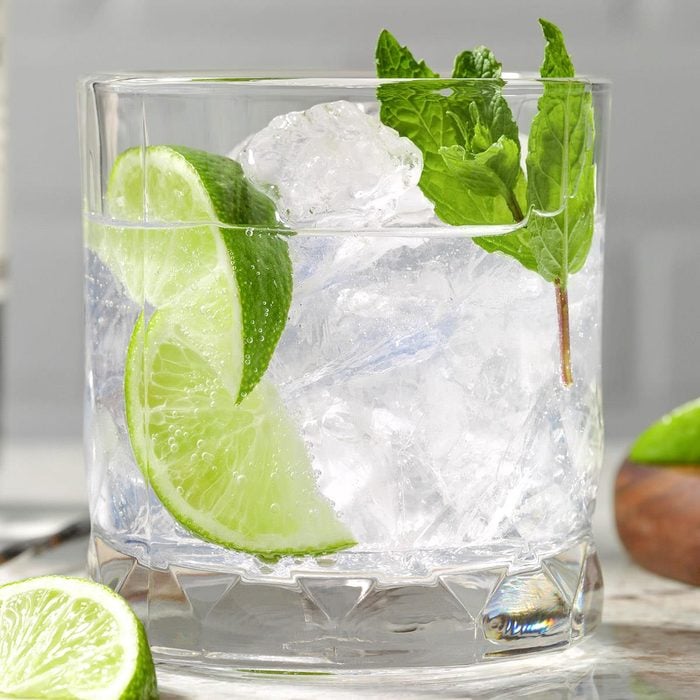A well-made gin and tonic is beautiful in its simplicity. A top choice among many classic gin cocktails, it is complex in flavor yet refreshing enough to drink as a cool down during the dog days of summer. The standard gin and tonic recipe is easy to follow—and easy to build on if you’re feeling adventurous.
What is a gin and tonic?
A classic gin and tonic (also known as a G&T) balances gin’s vibrant flavor with bittersweet, effervescent tonic water, a carbonated soft drink flavored with quinine. Quinine (a bitter-flavored powder derived from cinchona bark) was originally used as a fever remedy and treatment for malaria. Too bitter to take on its own, the powder was paired with sugar and soda water to help it go down easier.
As with many two-ingredient cocktails, a gin and tonic can be bright and zesty, light and refreshing, or sweet and bitter—all depending on the quality of its ingredients. Some tonic water brands are very sweet while others are dry with a more pronounced bitterness. When it comes to gin, most are flavored with juniper, coriander and citrus. However, you can also run into gin flavored with florals, fruits, herbs and spices of all sorts.
The Best Gin for a Gin and Tonic
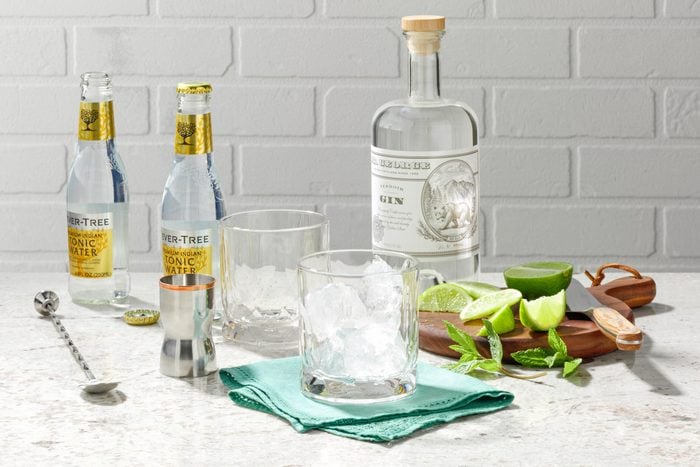
London dry gin is the go-to style for a gin and tonic recipe. Despite its name, London dry can come from anywhere in the world. While the exact flavors vary slightly, expect this style to have juniper, coriander and citrus notes. It’s clean and bright—exactly what you want in a gin and tonic. Beefeater, Plymouth and Bombay Sapphire are three common brands.
Of course, you can certainly reach for any gin you have on hand (like any of these gins for a Negroni). Just keep in mind that the more delicate, subtle gins may be overpowered by a strong tonic. And since a lot of those gins come with a heftier price tag, you may want to give some thought before opening one of those bottles. Personally, I’d save those gins for a nice martini.
Gin and Tonic Ingredients
- Gin: London dry gin is the classic choice for gin and tonics, but feel free to use any gin you have in the cabinet. Other than containing juniper, gin has no set standards for what flavors can be added. Try different blends until you find one you really like.
- Tonic water: We recommend buying a small bottle of tonic water. The larger bottles tend to lose their bubbles by the time you get to the end. Or make your own tonic water by mixing prepared tonic syrup with club soda or homemade bubbly water from a soda maker.
- Lime wedges: Lime adds a bright, sour note that cuts through the alcohol. You can use lemons instead, but the flavor profile will differ slightly.
Directions
Step 1: Chill your glass
Fill a highball glass with ice.
Editor’s Tip: To make the cocktail look fancy, use clear ice cubes.
Step 2: Build the cocktail
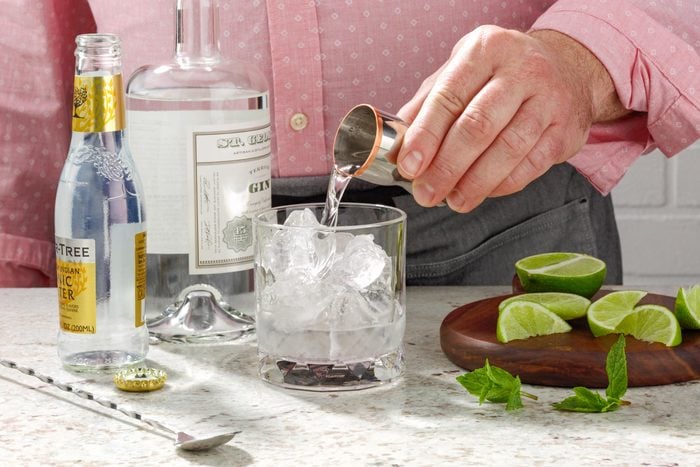
Add the gin to the glass.
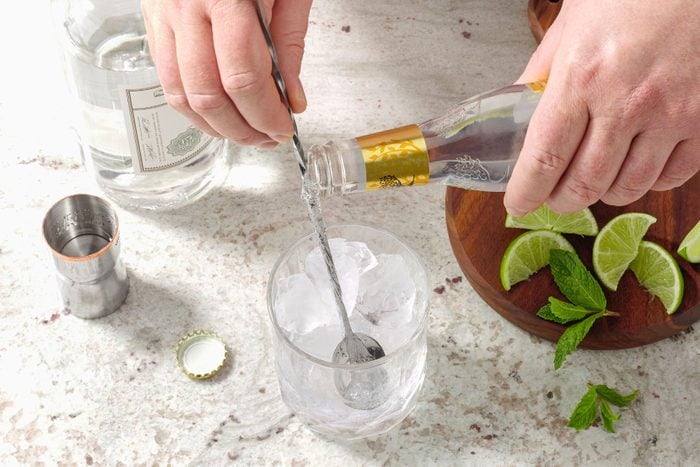
Slowly pour the tonic water over the ice, and gently stir to combine. Garnish with lime wedges.
Editor’s Tip: For the maximum number of bubbles, chill the tonic water in the refrigerator and wait to open it until the last minute. If you have a bar spoon with a twisted stem or handle, place it in the glass and slowly pour the tonic water down the stem of the spoon. This is supposed to retain more of those nose-tickling bubbles than pouring it directly into the glass. Alternately, if you do not have a bar spoon, bring the neck of the tonic water bottle as close to the ice cubes as possible, then fill the glass slowly.
Gin and Tonic Variations
- Swap in pink gin: Pink gin is fruitier, thanks to the addition of red fruits like strawberry, raspberry and currants. If you love juicy-fruit flavors, swap in pink gin for the London dry.
- Use flavored tonic: Pick up a bottle of flavored tonic water to introduce another layer to your cocktail.
- Reduce the sweetness: Swap in club soda for the tonic water to make a gin rickey.
- Include a flavorful garnish: Most people use a lime garnish, but others swear that a lemon wedge does a better job of bringing out the gin’s floral, citrusy notes. Feel free to experiment with any type of citrus (even orange or grapefruit). Woody herbs like rosemary or thyme also make a delightful garnish for gin and tonic.
- Add fruit: Crush fruit like blackberries or strawberries in the glass with a cocktail muddler or the back of a bar spoon. If you don’t have a home bar setup, you can simply add citrus peels or sliced cucumbers.
Can you make a gin and tonic in advance?
We don’t recommend making this gin and tonic recipe in advance. As soon as the bubbly tonic water goes flat the drink won’t taste the same. If you have leftover tonic water, you can save it in the refrigerator. However, it won’t be as effervescent as a freshly opened bottle of chilled tonic water.
Tips for Making a Gin and Tonic
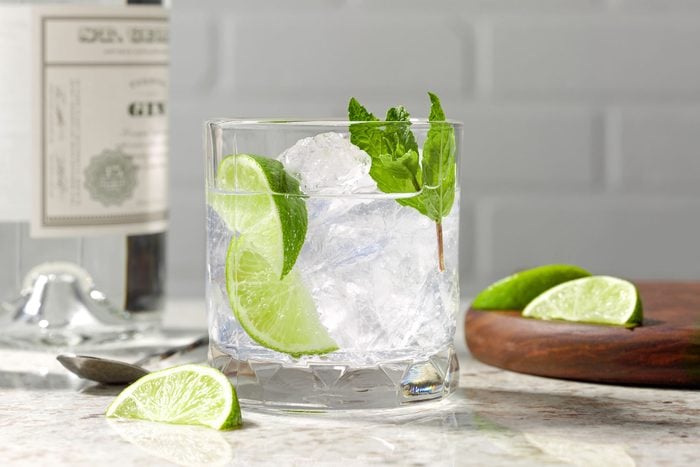
Is a gin and tonic a healthy drink?
Compared to complex cocktails made with sugary soda, fruit juice or sour mix, a gin and tonic could be considered a healthy alternative. Calories vary depending on the brand of tonic water, but most gin and tonics come in at about 190 calories. You can switch to diet tonic or cut down to 1-1/2 ounces gin to further reduce the calorie count.
Juniper berry (the major flavor behind gin) boasts several important health benefits too. These small blue-hued berries can aid digestion and reduce bloating. They’re also rich in antioxidants, which may have immune boosting and anti-inflammatory properties. That said, any alcohol should be consumed in moderation. You can have your gin and drink it too, just don’t go overboard.
Is a gin and tonic strong?
Gin and tonics can be very strong depending on the type of gin used. Gin is a strong alcohol, starting at 40% ABV (with navy strength gin exceeding 57% ABV). The ratio of gin to tonic water is also a factor. We use a 1:2 ratio (one part gin to two parts tonic water). However, you can change the ratio to 1:3 to reduce the drink’s alcoholic strength.
